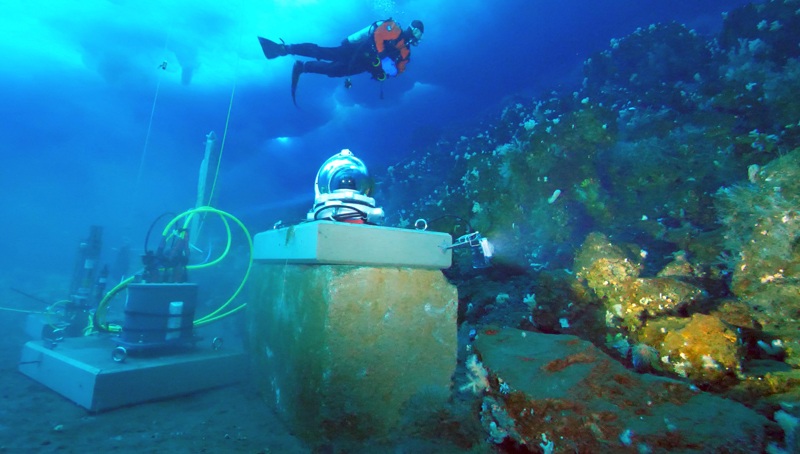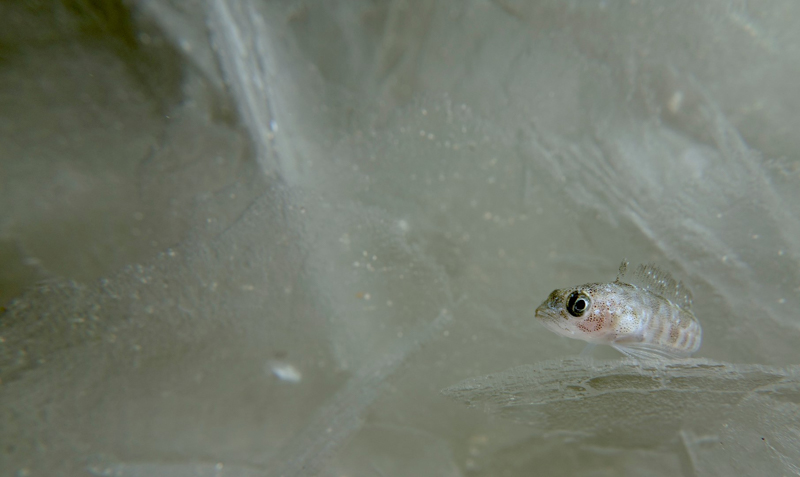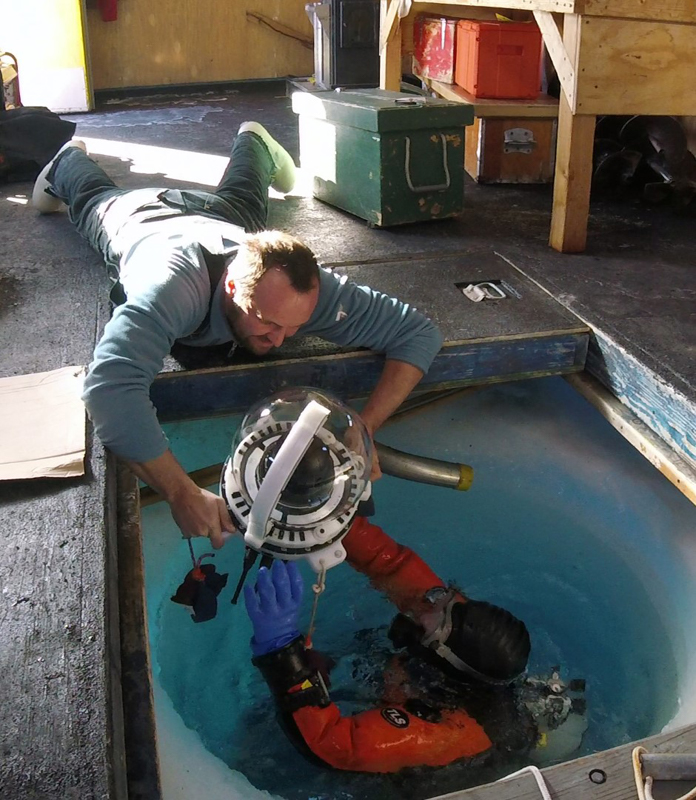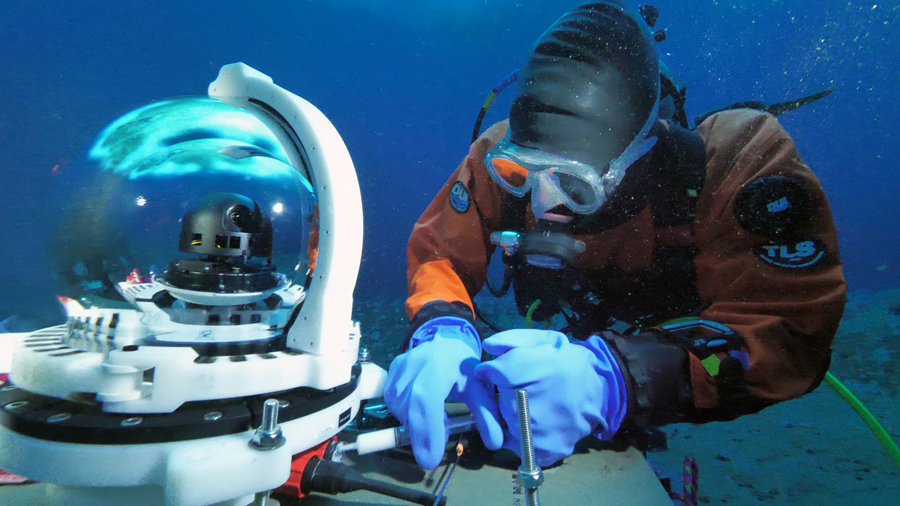Why Antarctic Fish Don’t Freeze Their Tails OffA New Underwater Observatory Monitors McMurdo Sound’s Oceanographic Changes in Real TimePosted April 9, 2018
An innovative project to understand how fish survive in the frigid Antarctic waters is opening up new avenues for researchers monitoring what goes on under the sea ice in McMurdo Sound. Evolutionary biologist Paul Cziko from the University of Oregon is studying how Antarctic fish don’t freeze into a solid block while spending their lives in subzero waters. To do so, he and his team installed a suite of underwater sensors to constantly monitor conditions in McMurdo Sound, the waters immediately offshore of McMurdo Station, the National Science Foundation’s logistics hub on the Southernmost Continent. The McMurdo Oceanographic Observatory, also known as the MOO, measures the temperature, salinity and pressure of the water. In addition, it sports a 360-degree, high-definition digital camera and a research-quality underwater microphone, all placed on the sea floor at 70-feet below the sea ice cover. All the data is transmitted in real time to the station, and archived for later use. His research is funded by the National Science Foundation (NSF), which manages the U.S. Antarctic Program. Getting a clearer picture of how the ocean changes over a day, as well as over a whole five-month research season, is important to understanding exactly what conditions Antarctic fish endure in nature, and how their special adaptations enable their survival. 
Photo Credit: Paul Cziko
Paul Cziko swims over the MOO camera. To its left is the suite of instruments that measure oceanic conditions and the underwater microphone.
The Sound’s salty waters hover around minus 1.9 degrees Celsius. The Notothenioid fish that live there have evolved special proteins in their blood to prevent ice from spreading through their bodies and killing them. When an ice crystal enters the body, these “antifreeze proteins” bind to the crystal, preventing it from growing and freezing the entire fish. “We want to be able to quantify the number of ice crystals that occur in the fish, and then quantify how that changes as a function of the environmental conditions that the fishes experience,” Cziko said. 
Photo Credit: Paul Cziko
A small Notothenioid fish swims amongst the sea ice. The fish’s blood contains special antifreeze proteins to prevent it from freezing solid.
These proteins were first identified in the 1970s but there’s still a lot of uncertainty about how the antifreeze proteins work within the fish, including how the fish process internal ice crystals. The proteins can’t stop environmental ice crystals from entering in the first place, but do prevent the ice from growing and overwhelming the animal. One of the outstanding questions is what does the fish do with these ice crystals after they’ve been contained. “They’re not going to grow, they’re not going to kill the fish instantly,” Cziko said. “Almost all the fishes in McMurdo Sound have some ice inside their bodies, but their bodies are not frozen solid, it’s a whole bunch of little crystals. But if they continue to accumulate over the 10 to 20-years of their lives, they could behave like blood clots, effectively creating a fish slushy.” 
Photo Credit: Paul Cziko
Biophysicist Konrad Meister (left) hands Paul Cziko the MOO camera to be installed on the sea floor.
Over the next few years, Cziko and his team will study fish caught in the waters off McMurdo Station to understand how these animals deal with the buildup of these ice crystals and what oceanic conditions bring them about. To do this, the team will start out by analyzing the fish’s spleens, an organ that filters out impurities from the bloodstream, which is where ice crystals seem to collect. “We don’t find ice regularly in most of the organs or blood. It mostly occurs in the spleen,” Cziko said. “It could be that it’s just passive – crystals are getting filtered and ending up in the spleen. It could be that there is some active mechanism that’s bringing crystals to the spleen where they’ll get destroyed or melted.” Using the MOO, Cziko and his team can monitor the ocean’s temperature, salinity and pressure, looking for when the waters seem most conducive for ice growth. When the conditions are right, the team can immerse the fish they’ve been keeping ice-free in the lab into in McMurdo Sound. After such “freezing events,” the researchers will count the number of microscopic ice crystals inside the fish, offering insight into how ocean conditions affect the accumulation of ice inside the fish. “Ice doesn’t form in the fish, it’s coming in from the outside,” Cziko said. The camera and hydrophone also help by allowing the researchers to watch the behavior of marine creatures, including the fish, in real time. The video and audio feeds are being presented on a monitor in McMurdo’s Albert P. Crary Science and Engineering Center, the largest laboratory on the continent, and broadcast onto one of the station’s local television channels. Some live data, images, and audio is accessible from the researchers’ home institutions, but due to internet bandwidth constraints, the majority of the data will be stored in an archive for researchers to retrieve yearly during their field research seasons at McMurdo Station. In addition, Cziko hopes that the MOO is the first of more such underwater instrument stations throughout McMurdo Sound and oceans surrounding Antarctica. “There really is something to be said about putting eyes and ears under the ice down here, and having that data available in real time,” Cziko said. “This is an unexplored environment. There’s stuff that’s happening all the time that is novel and unknown.” NSF-funded research in this story: Paul Cziko of the University of Oregon, Award No. 1644196. |
"News about the USAP, the Ice, and the People"



For USAP Participants |
For The Public |
For Researchers and EducatorsContact UsU.S. National Science FoundationOffice of Polar Programs Geosciences Directorate 2415 Eisenhower Avenue, Suite W7100 Alexandria, VA 22314 Sign up for the NSF Office of Polar Programs newsletter and events. Feedback Form |



